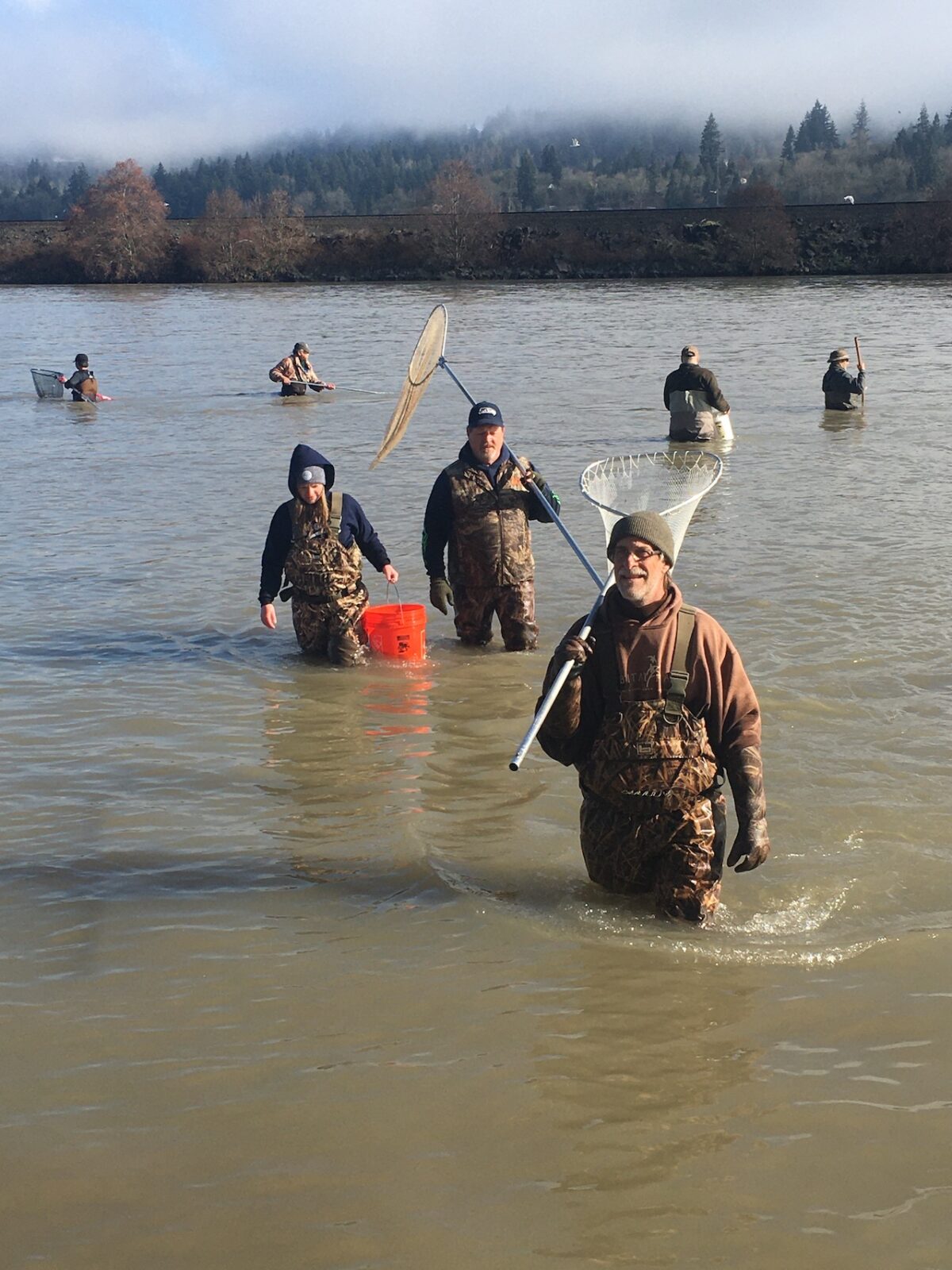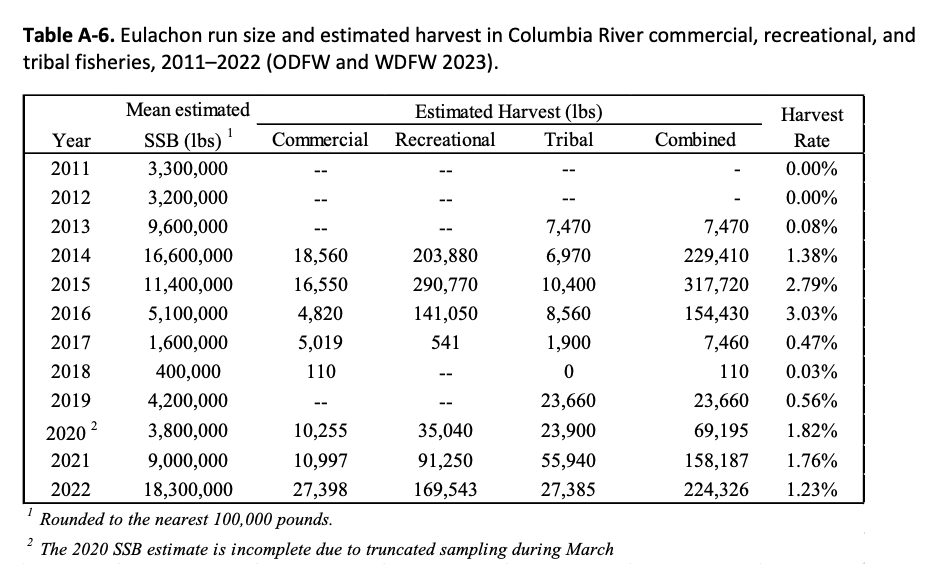
Watching And Waiting Time For Smelt Dippers
It’s officially watch and wait time for smelt dippers.
Columbia managers set a research-level commercial fishery this morning that will help determine if enough eulachon are coming up the big river to warrant an opener on Washington’s Cowlitz.

According to WDFW and ODFW, this year is forecast to see a “moderate to strong return … similar or slightly lower in magnitude than the 2023 return of 17 million pounds,” which itself was termed “above-average” for the past decade.
While last year’s run did eventually provide for an unexpected seven-hour late March opener on Oregon’s Sandy, the smelt were so unusually tardy that they overlapped with releases of hatchery spring Chinook smolts swimming down the Cowlitz, essentially negating any chance of dipnetting there, according to WDFW’s Matthew Sturza.
Now, the eyes of the region’s smelt smokers, eulachon fryers and sturgeon anglers will be reading the portents of seals, fish-eating birds and Lower Columbia water temperatures for signs of the skinny oily fish. Our MD Johnson reported spotting a family of otters noshing on some at the mouth of the Grays just as the recent Big Cold descended, which left the Columbia running at 36 degrees, 4 degrees below the five-year average and probably slowing the temp-sensitive fish somewhat.
Managers will be using their own augury, of course, the recently updated joint state management plan for the Endangered Species Act-listed stock, which was lauded by agency managers during today’s Columbia River Compact call.
It features a somewhat complex table that combines a number of factors – recent forecast averages, run size trends and an assessment of this year’s expectations – to assign a “harvest phase” level to a given year.
All told there are four harvest phases, with permutations inside each level as well. Under Harvest Phase 1, when runs are expected to come in below 1.5 million pounds of smelt, only commercial research fisheries will be held so as to continue biological monitoring of the run. Under Harvest Phase 4, when more than 20.5 million pounds of fish are expected, a 10 percent harvest rate is allowed for commercial and recreational harvesters.
The smelt plan also includes “in-season harvest triggers” that allow managers to move between harvest phases based on daily commercial catch deliveries.
As it stands, 2024 falls into Harvest Phase 2, the minimum needed to consider a recreational opener and which allows for a 2 percent harvest rate. But for dipnetting to be considered on the Cowlitz, managers need to see at least one day of commercial fishing effort that brings in a minimum of 200 pounds per delivery.
The commercial season that ODFW and WDFW set today opens the Lower Columbia on Mondays, Wednesdays and Thursdays starting tomorrow through March 14.
That’s one more day of the week than recent seasons, with the idea being that while netboat effort has decreased, there’s still a need to collect biological info about the run, and the additional time on the water may better match tides more suitable for netters.
The nuance of allowing more time for commercial netting to determine potential recreational openers may be lost, however, given the powerful emotions around Columbia comm-sport allocations, but since the 2010 listing of the species, bankbound netters have actually caught 10 times more smelt than their boatborne brethren because they benefit as stream size constrict the fish to running up tributary shorelines.
Commercial landings have ranged from zero (2011-13 and 2019) to 27,398 pounds (2022), for an overall 13-year haul of 95,431 pounds.
Cowlitz recreational dippers have harvested from zero (2011-13, 2019, 2023) to 290,770 pounds (2015), for a 2011-2023 haul of 932,074 pounds.
Add in the Sandy’s 2015 and 2023 openers and the rec-comm disparity grows even larger.
(Oregon managers have a little more flexibility for setting a Sandy opener. ODFW also timed last March’s fishery so that it occurred between sets of spring Chinook smolt releases, an agency staffer said today.)

Tribes in the region also harvest smelt, and during today’s call, Mark Manion, harvest biologist for the Confederated Tribes of the Warm Springs Reservation, said he supported the commercial research fishery.
With no public comment against it, ODFW’s Geoff Whisler, representing Director Curt Melcher, moved to adopt the proposed opener and he was seconded by WDFW’s Charlene Hurst, representing Director Kelly Susewind.
Hurst praised the staff work that went into the updated smelt management plan, saying a lot of effort had gone into putting into writing what state overseers go through to provide opportunities.
If the Columbia is a little too far to keep your eye on for eulachon, she encouraged folks to check out a new WDFW webpage dedicated to Cowlitz smelt for official news.
And for the latest commercial landings, see this ODFW webpage.
ONE OTHER NOTE ON SMELT. Lawmakers in Olympia are again mulling a bill that would require dipnetters to buy a Washington fishing license to participate on the Cowlitz.
WDFW Capt. Jeff Wickersham told the Senate Agriculture, Water, Natural Resources & Parks Committee last week that while the fishery doesn’t require a license, dippers are still expected to abide by the rules, though not all do.
“During the last public fishery in 2022, over 16,000 individual dippers participated and the average harvest per person was more than the 10-pound limit. Over 70 percent of individuals cited had not purchased a fishing license in more than five years, if ever. If there was a license requirement, anglers would be held to a higher standard of conduct and would have guaranteed access to the fishing rules via the state-issued fishing pamphlet. We seek to educate the public on our rules and regulations prior to fishing, not after a violation has occurred,” Wickersham said.
He added that anglers with a current freshwater or combo license would already be covered to dip for smelt.
A license has been required to dip in Oregon since 2017, according to that aforementioned management plan.
It also details how smelt dipping used to be open year-round on Lower Columbia tributaries, with a 20-pound daily Washington limit, 25 pounds in Oregon.
But poor abundances seen in the late 1990s led to closures, the ESA listing and only occasional openers with reduced limits in the years.
